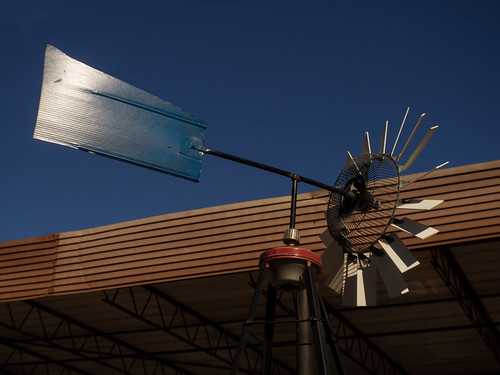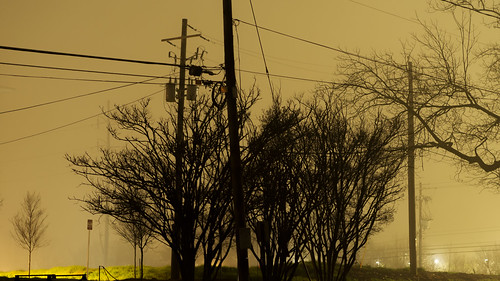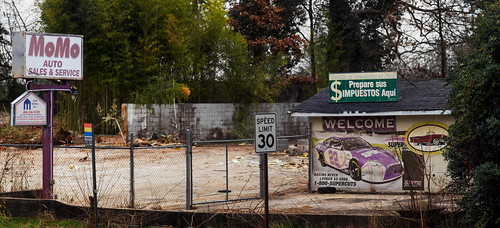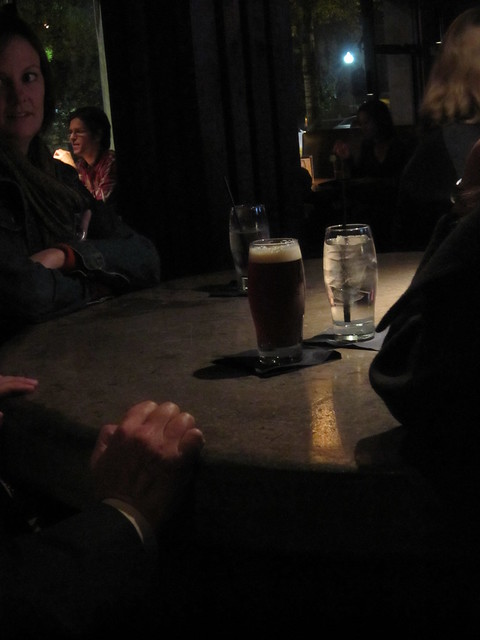
Built from auto-parts, a homemade weather vane indicates a breeze blowing from the northeast.
As seen at an auto-body repair shop, in the Reynoldstown area of Atlanta, Georgia, USA, on 22 February 2020.
NB. A weather vane points in the direction that the wind is coming from.
-----more-----
Saturday, February 29, 2020
Pic(k) of the Week: Which way is the wind blowing?
Labels: Atlanta, gentrification, Georgia, Pic(k) of the Week, southeastern US, weather
Saturday, February 22, 2020
Pic(k) of the Week: Brumous night
Brume: "fog, mist."
One of those wonderful borrowed words not used frequently in English nowadays. Merriam-Webster: "French, mist, winter, from Old Occitan bruma, from Latin, winter solstice, winter; akin to Latin brevis short."
In the city evening brume, on 8 February 2020, in Decatur, Georgia, USA.
-----more-----
Wednesday, February 19, 2020
Innovation in 'craft' brewing.
On 18 February 2020, beer writer Stan Hieronymus hosted the "Ask Me Anything" weekly one-hour broadcast at the Facebook group "Craft Beer Professionals." Technology misbehaved as it often does...with glitches. So, Mr. Hieronymus conducted things in writing rather than via Skype. Well, via Facebook posts, that is.
Early on, he was asked:
The past decade we have witnessed enormous growth in craft beer. What do you believe will be the guiding principle for the next 10 years? Great beer? Great business skills? Innovation?"
He answered:
...The growth in the number of breweries is larger than the growth in sales. Brewing very good, flaw-free beer gets you in the game. Writing a realistic business plan keeps you there. If by innovation you mean novelty, that is overrated. If by innovation you mean taking advantage of what technology has to over, then it is underrated."
Words to brew by.
-----more-----
Tuesday, February 18, 2020
And so it has come to this.
In this supermarket, cases of hard seltzer dominate the floor of its refrigerated beer aisle. In just a few years, seltzer has come to dominate beer and 'craft' business to a significant extent.
***************
And so it has come to this.
- Hard seltzer is taking the US by storm. Sales of the canned fizzy beverages from brands like Whiteclaw, Truly, and Bon & Viv have boomed over the last year. The category, currently worth $550 million, could grow to reach $2.5 billion by 2021, said Sean King, an analyst at UBS. That implies an annual growth rate of 66% and a jump in consumption from 14 million cases in 2018 to 72 million cases in 2021.— Markets Insider (30 July 2019)
- Hard seltzer is what it sounds like, a seltzer spiked with alcohol. At their most basic, hard seltzers have three ingredients: carbonated water, alcohol, and flavoring. Many brands infuse their seltzers with alcohol from fermented cane sugar. Some also use malted barley, like the throwback spiked seltzer-like beverage, Zima, which was created in 1993 by Coors. As non-alcoholic seltzer has risen in sales year after year, hard seltzer has skyrocketed in tandem. By 2021, some analysts predict hard seltzer could be a $2.5 billion industry. It’s experienced market growth of 200% so far this year alone.— Wine Enthusiast (20 September 2019)
- Hard seltzers have positioned themselves at the nexus of convenience and health. These carbonated water-based ready-to-drink [RTD] cocktails, which are made either from malted barley or fermented sugar, typically clock in at 100 calories or less per serving, compared with heavier beers, wines, or cocktails that have from 100 to 400 calories per serving. They’re low in alcohol as well, ranging from 4.5% to 6% ABV. They’re also gluten-free [...] besides offering the convenience of a shatterproof portable can. [...] Pricing varies, but hard seltzers are usually cheaper than craft beer and definitely less expensive than a mid-range bottle of wine or spirits.— SevenFifty Daily (12 April 2019)
- Typical of the bunch is Truly Hard Seltzer in blueberry and açaí flavor, which comes in 12-ounce slim cans, each with 100 calories, 5% alcohol, and two grams of carbs—gluten-free, of course. Truly is made by Boston Beer, whose name belies its recent focus. Beer, including Samuel Adams, makes up just under one-third of estimated company volumes. The rest comes from hard cider, tea, and seltzer. Boston is No. 2 in hard seltzer, with 26% of the market, behind privately held Mark Anthony Brands and its White Claw line, with 59%.— Barron's (12 February 2020)
- Sales of hard seltzer have now exceeded $585 million for the 52-week period that ended on March 23, 2019, according to Nielsen. This represents approximately 1.4 percent of the total beer/flavored malt beverage/cider market. In dollar sales, the category grew 185 percent, compared to a year ago, while unit sales grew 196 percent. While seltzer continues to grow its market share aggressively across Nielsen’s measured off-premise outlets, other segments of the market are flattening. During the 52-week period that ended on February 23, 2019, beer/flavored malt beverage/cider sales grew 0.9 percent, according to Nielsen, while wine sales expanded 2.4 percent and spirits sales increased 3.8 percent in the same period.— SevenFifty Daily (12 April 2019)
As Alan McLeod (of A Better Blog) commented (not so) tongue-in-cheek:
The BA [U.S. Beer Association] just needs to adjust the definition of craft beer to solve this.
-----more-----
Saturday, February 15, 2020
Pic(k) of the Week: Bye, bye, MoMo
From sold to razed in three weeks, a long-time, one-stop combo junkyard, used car dealer, auto repair shop, tax preparer, and money services firm —in English y en Español—is no more. Bye, bye, MoMo.
Urban displacement in DeKalb County, Georgia, USA.
-----more-----
Saturday, February 08, 2020
Pic(k) of the Week: Third Man postern
The side stairs, gate, and door to Third Man Records, in Nashville, Tennessee. Photo taken 2 February 2018.
The southern digs of Detroit-based musician Jack White (of the White Stripes), Third Man Records serves as a
record store, novelties lounge, photo studio, live venue with direct-to-acetate recording capabilities, label offices, and distribution center.
...with quite the cool postern.
"I'm gonna fight 'em off.
A seven nation army couldn't hold me back.
They're gonna rip it off,
Taking their time right behind my back."
-----more-----
A seven nation army couldn't hold me back.
They're gonna rip it off,
Taking their time right behind my back."
Sunday, February 02, 2020
Beer-Cheese Dip
There's something to celebrate — beer isn't just "beer' anymore; it; a delightful beverage to share with family and friends who appreciate quality ingredients in cooking and a new experience in American cuisine. There is nothing "common" about beer anymore.
Written in 1989 by Jack Erickson, Great Cooking! With Beer is a snapshot of American beer 'culture' in the 1980s, when 'craft' beers were called "microbrews" and beer 'culture' was a nascent thing to be coddled. 1 Of course, it was also a cookbook: a useful beginning point for learning about beer IN food. And it remains so today (though sadly out-of-print).2
Mr. Erickson lived in the northern Virginia area through the early 1990s, where he evangelized on the goodness of the new-fangled microbrews. I met him there on a few occasions. I never gathered up the nerve to make his recipe for "Beer Syrup" for pancakes (for which he admonished me), but I have prepared (and enjoyed) other of his recipes, including Beer-Cheese Dip.
Today, the Sunday of Super Bowl LIV, it might be a good day to post about that. So, here's the recipe, but with some personal adaptions. 3
***************
Recipe
INGREDIENTS- 2 cups (6-8 ounces) shredded cheddar cheese, at room temperature
- 2 ounces cream cheese, at room temperature
- 1 tsp dry mustard powder
- 1 clove garlic, mashed...or 1/4 tsp garlic powder (see note below)
- 1 tsp (vegan) Worcestershire sauce 4
- 1/2 tsp black pepper
- 1/2 tsp turmeric
- 1/2 tsp onion powder
- 1/2 tsp cumin
- 1/4 tsp cayenne pepper (or more to taste)
- 1 tsp malt vinegar
- 1/2 cup (4 ounces) light lager (e.g., PBR: Pabst Blue Ribbon)
- 1 dash smoked Spanish paprika
- scant handful spring onions, chopped
- Combine cheddar, cream cheese, mustard, pepper, turmeric, onion powder, cumin, garlic, vinegar, cayenne, and Worcestershire in a food processor or blender. (No salt needed; the cheese will be salty enough!)
- Process/blend 30 seconds to blend.
-
NOTE:
When recently re-making the dip, the taste of the single fresh garlic clove overpowered the dish. So, I would recommend first blending all else and only then adding a little at a time of the smashed garlic to the blender/processor and checking for flavor before (or not) blending more. - With processor/blender running, add the beer gradually, blending until the mixture is 'peanut-butter' smooth, not runny. Add more, only if necessary.
- Transfer the mixture to a serving bowl and refrigerate for at least an hour to allow the flavors blend.
- Before serving, bring to room temperature. Garnish with chopped spring onions and a dash of paprika. Serve with raw vegetables.
Great Cooking! With Beer
- Author: Jack Erickson
- Paperback, hardcover: 146 pages
- Publisher: Redbrick Press (February 1989)
- Language: English
- ISBN-10: 0941397017
- ISBN-13: 978-0941397018
- 1 American beer writer Vince Cottone is credited with first using the term "craft brewery" in print in 1986, although it didn't enter the common usage until more than a decade later.
- 2 Erickson also wrote several beer travelogues, themselves snapshots of 'microbreweries' of the 1980s and early 1990s. These are also out-of-print, but you cna find them if you search for second-hand sources.
- 3 See Erickson's original recipe: here.
- 4 Worcestershire sauce, although fermented from barley malt, also contains anchovies. There are non-fish, vegan/vegetarian alternatives.
- Vegan? Try this 21st-century recipe for a Beer-Cheese Dip, with no actual cheese, from blogger Rabbit and Wolves. Almond milk and nutritional yeast supply the 'cheesiness.' It's tasty.
- For more from YFGF:
- Like on Facebook: YoursForGoodFermentables.
- Follow on Flickr: Cizauskas.
- Follow on Instagram: @tcizauskas.
Labels: beer book, beer cookery, beer culture, breweriana, cheese, craft beer history, recipe, vegetarian, VeggieDag
Saturday, February 01, 2020
Pic(k) of the Week: Cask ale in light and shadow
Merriam-Webster defines the word eventide as "the time of evening." The first recorded use of the word was nine centuries ago, in the 1100s. These days, eventide is in the lower 40% percentile of words looked up. That's a shame. It adds an ineffable character to mere evening.
And, it seems a good word for this scene.
In
And what was that beer which was holding their interest?
No answer as to ownership but as to brewery-ship, it was "Winter Storm Category 5 Ale," a brewery-styled 'Imperial ESB' of 7.5% alcohol-by-volume (abv), brewed and conditioned by Heavy Seas Beer, a large 'craft, brewery in Halethorpe, Maryland. More than that, the ale was served cask-conditioned, fresh from a firkin (10.8-US gallon cask).
Why the 'eventide' reference?
With a capital 'E," that is the name of the Arlington, Virginia restaurant and wine bar that was serving this real ale, rather than offering an afterthought beer, say, Miller Lite or such.
A wintry beer blast-from-the-past, the photograph was taken in 2010. Alas, the restaurant is no more (not, I believe, from serving good beer). The brewery, Heavy Seas, remains in operation today.
Other than hops, the brewery had added nothing else to the fermenting beer in the firkin, no willy-nilly frou-frou, not gratuitously flavored but beer-flavored. It was brewery-fresh ale, as if the brewery had brought a beer-full fermenter —albeit on magnitude tens of times smaller than in the brewery— to this restaurant.
Real ale.
-----more-----
Subscribe to:
Posts (Atom)


















